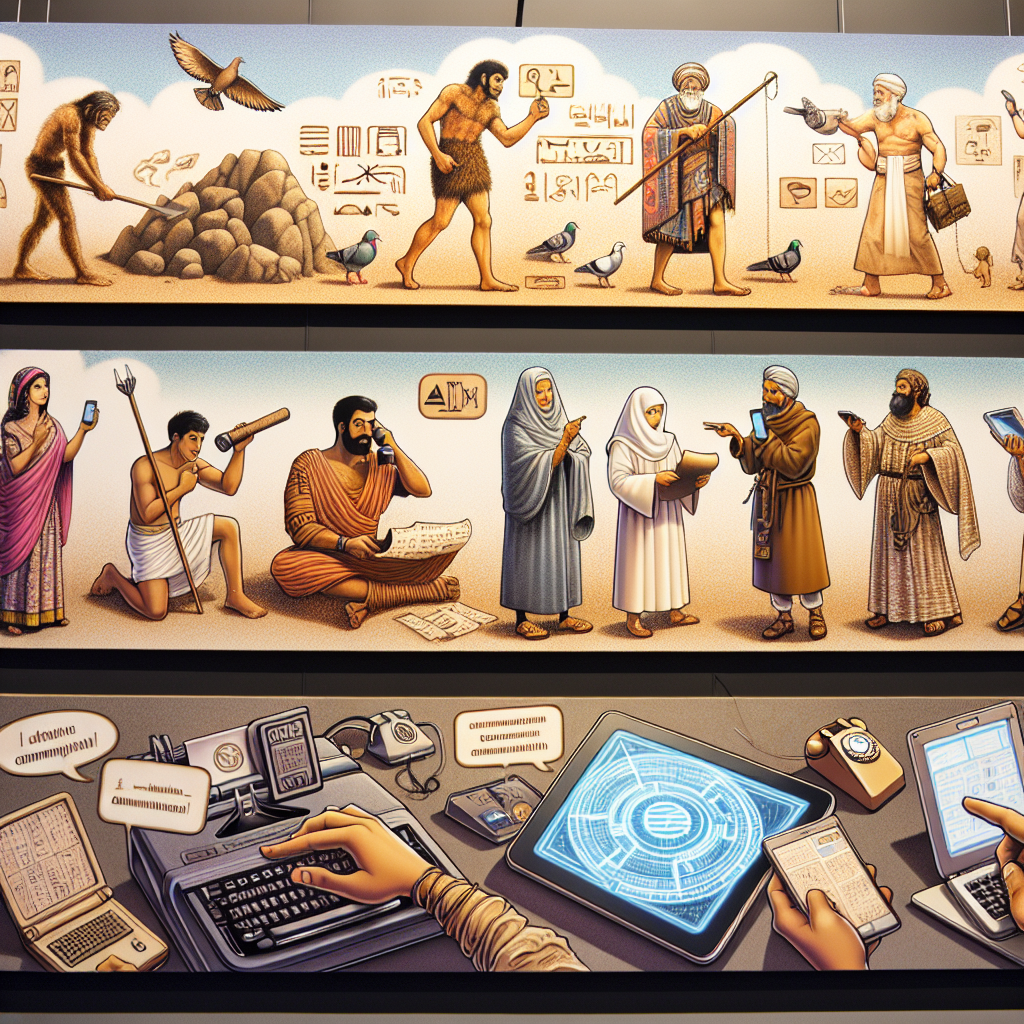In every relationship, communication serves as the foundation for understanding, trust, and connection
Communication is a fundamental part of our daily lives. Whether we're speaking to friends, writing an email, or sending a text message, we are constantly exchanging information. But have you ever stopped to think about the various ways we communicate? Understanding the diverse methods of communication can enhance our interactions and improve our communication skills.
Communication can be broadly categorized into four main types: verbal, non-verbal, written, and visual. Each has its own unique set of skills and applications. These diverse methods allow us to connect with others in different contexts, making it essential to develop proficiency in each to navigate our personal and professional lives effectively.
Verbal communication is the most common form of communication. It involves the use of spoken words to convey a message. This type of communication is essential in everyday interactions, from casual conversations to formal presentations. The ability to articulate thoughts clearly and respond appropriately to others in dialogue is a vital skill.
The context in which verbal communication occurs significantly influences how messages are conveyed and received. Factors such as the setting, the relationship between communicators, and cultural backgrounds play a pivotal role. Understanding these elements can help tailor messages appropriately, ensuring they are received as intended.
Feedback is a crucial component of verbal communication, as it provides an opportunity for clarification and improvement. Constructive feedback can refine one's speaking skills, while positive reinforcement can boost confidence. Encouraging an open feedback loop fosters a more effective and engaging dialogue.
Despite its common use, verbal communication can face several barriers, including language differences, jargon, and emotional states. Being aware of these potential obstacles allows for proactive measures, such as simplifying language or addressing emotional concerns, to ensure clear and effective communication.
Clarity and Conciseness: Speak clearly and get to the point to avoid misunderstandings. Being succinct ensures that the core message is not lost in unnecessary details.
Active Listening: Pay attention to the speaker, show interest, and provide feedback. This not only shows respect but also enhances understanding and engagement in the conversation.
Tone and Pitch: Use an appropriate tone and pitch to convey your message effectively. A well-modulated voice helps in emphasizing points and keeping the listener's attention.
Non-verbal communication involves the use of body language, facial expressions, gestures, and eye contact to communicate without words. It can reinforce what is being said verbally or convey a message on its own. This form of communication is often subconscious but plays a powerful role in the perception of messages. https://www.couples-campus.com/to-make-someone-trust-you-again/
Cultural backgrounds heavily influence non-verbal communication. Gestures and expressions that are commonplace in one culture might be offensive or misunderstood in another. Being culturally aware and sensitive is crucial in a globalized world to avoid misinterpretations.
The alignment between verbal and non-verbal cues can significantly impact message credibility. Discrepancies between spoken words and body language might lead to confusion or mistrust. Learning to synchronize these cues enhances communication effectiveness and authenticity.
In the digital age, where face-to-face interactions are limited, non-verbal communication still plays a role through elements like emojis, GIFs, and video calls. Understanding how to convey emotions and responses in these formats is essential for maintaining clarity and connection in virtual communications.
Body Language Awareness: Be conscious of your posture, gestures, and facial expressions. This awareness ensures that your non-verbal signals align with your verbal messages.
Eye Contact: Maintain appropriate eye contact to show confidence and engagement. It helps establish trust and indicates attentiveness.
Facial Expressions: Use facial expressions to complement your verbal message. A smile or nod can reinforce positive communication, while a frown might indicate disagreement or confusion.
Written communication is the expression of ideas through written words. This form of communication is crucial in both professional and personal contexts, such as emails, reports, and social media posts. It allows for the documentation and sharing of information that can be revisited and analyzed over time.
The tone in written communication is often inferred from word choice and sentence structure. Misinterpretations can occur if the tone is not clear. Being mindful of how words might be perceived helps prevent misunderstandings and fosters a positive exchange.
With the advent of digital tools, written communication has evolved to include platforms like emails, text messages, and social media posts. Each platform has its own norms and expectations, requiring adaptability in writing styles to suit different audiences and purposes.
Proofreading is a critical step in written communication to ensure accuracy and professionalism. Errors can undermine credibility and clarity. Taking the time to review and edit written content is essential for effective communication.
Grammar and Spelling: Use correct grammar and spelling to ensure clarity. Mistakes can distract from the message and create confusion.
Structure and Organization: Organize your ideas logically with clear headings and paragraphs. A well-structured document facilitates understanding and engagement.
Tone and Style: Adapt your tone and style to suit the purpose and audience. A formal tone might be necessary for business correspondence, while a casual tone could be more appropriate for personal communication.
Visual communication involves the use of visual elements to convey a message. This can include images, graphs, charts, and videos. It's an effective way to simplify complex information and capture attention. Visuals can transcend language barriers and enhance comprehension.
Visual communication leverages cognitive psychology principles, such as color theory and spatial relationships, to influence perception and memory. Understanding how visuals impact the brain can enhance the design and effectiveness of visual messages.
Combining visual elements with verbal or written communication can amplify the impact of a message. For example, presentations that use slides or infographics can help illustrate points more vividly than words alone.
With the rise of digital media, visuals have become integral to online communication. Platforms like Instagram and YouTube prioritize visual content, making it essential for communicators to develop skills in creating engaging and informative visuals.
Design Principles: Use design elements like color, layout, and typography effectively. These principles guide the viewer's attention and enhance message clarity.
Clarity and Simplicity: Ensure visuals are clear and simple to understand. Overly complex designs can confuse rather than inform.
Relevance: Choose visuals that are relevant to the message being communicated. Irrelevant visuals can distract and dilute the intended message.

Recognizing the different methods of communication can significantly improve how we express and interpret messages. Here are some reasons why understanding these methods is important:
Effective communication is key to building and maintaining relationships. By understanding the different ways people communicate, you can better connect with others, resolve conflicts, and foster collaboration. It fosters trust and mutual respect, paving the way for stronger personal and professional bonds.
Trust is the foundation of any relationship, and communication plays a vital role in establishing it. Consistent, honest, and transparent communication helps build trust, making it easier to navigate challenges and disagreements.
Misunderstandings and conflicts are inevitable, but effective communication skills can help address and resolve these issues. By understanding various communication methods, individuals can approach conflicts with empathy and clarity, leading to more productive resolutions.
In professional settings, the ability to communicate effectively with diverse teams is crucial for collaboration. Recognizing different communication styles and adapting to them can lead to more inclusive and innovative teamwork.
Good communication skills enable you to express your ideas clearly and understand others' perspectives. This can lead to better problem-solving and more informed decision-making. Effective communicators can identify the root of a problem and work collaboratively to find solutions.
Open communication encourages the exchange of ideas and perspectives, which is essential for problem-solving. By facilitating open dialogue, diverse viewpoints can be considered, leading to more comprehensive solutions.
Active listening is a cornerstone of effective communication, allowing individuals to gain insights from others. By truly understanding different perspectives, more informed and balanced decisions can be made.
Feedback is invaluable in refining decision-making processes. Constructive feedback helps identify areas for improvement and reinforces successful strategies, leading to better outcomes.
When communication is clear and effective, tasks are completed more efficiently, and productivity increases. Misunderstandings and errors are reduced, leading to a smoother workflow. Effective communication streamlines processes and enhances the overall functionality of teams and organizations.
Clear communication of instructions and expectations ensures that tasks are understood and executed correctly. This reduces the need for rework and minimizes errors, enhancing overall efficiency.
Effective communication minimizes the potential for misunderstandings, which can lead to costly mistakes. By ensuring clarity and comprehension, errors are reduced, and productivity is boosted.
Good communication fosters a positive team environment, where members feel valued and understood. This boosts morale and motivation, leading to increased productivity and job satisfaction.
People have different communication styles based on their personalities, cultures, and experiences. Understanding the various methods of communication allows you to adapt your style to suit different situations and audiences. This adaptability is crucial in a diverse world where one size does not fit all.
Recognizing different communication styles, such as assertive, passive, or aggressive, helps tailor interactions. Understanding these styles enables more effective communication and reduces potential conflicts.
Cultural sensitivity is essential in today's globalized world. Adapting communication to respect cultural nuances enhances understanding and prevents misinterpretations.
Diverse teams bring varied communication styles and perspectives. Leveraging this diversity can lead to richer discussions and more innovative solutions, provided communication is adapted to include all voices.
In today's digital age, technology has transformed the way we communicate. Here are some modern communication methods that have become increasingly popular:
Social media platforms like Facebook, Twitter, and Instagram allow users to share information, connect with others, and engage with content in a dynamic way. They offer a blend of written, visual, and sometimes verbal communication. These platforms have revolutionized how we interact and share information on a global scale.
Social media has the power to build and nurture communities around shared interests and causes. These platforms offer spaces for like-minded individuals to connect, share ideas, and support each other.
Businesses and individuals use social media for marketing and influencing. Effective communication on these platforms can enhance brand visibility and engagement, leading to increased reach and impact.
Despite its benefits, social media communication comes with challenges like misinformation and privacy concerns. Understanding these risks and communicating responsibly is crucial for maintaining credibility and trust.
Apps like WhatsApp, Telegram, and Slack have revolutionized communication by offering instant messaging, voice calls, and video chats. They provide a convenient way to stay in touch with friends, family, and colleagues. These apps have become indispensable tools for personal and professional communication.
Instant messaging apps offer unparalleled speed and convenience, allowing for real-time communication. This immediacy enhances connectivity and responsiveness in both personal and professional interactions.
Messaging apps facilitate collaboration by providing features like group chats and file sharing. These tools enable teams to communicate and collaborate efficiently, regardless of geographical location.
While messaging apps are convenient, maintaining a balance between informality and professionalism is essential. Understanding the context and audience helps in choosing the appropriate tone and style for communication.
Video conferencing tools such as Zoom, Microsoft Teams, and Google Meet have become essential for remote communication. They enable face-to-face interactions without the need for physical presence, making them ideal for business meetings and virtual gatherings. These tools have transformed how we work, learn, and socialize in a digital world.
Video conferencing bridges the gap between in-person and remote interactions, offering visual cues that enhance communication. This face-to-face element helps in building rapport and understanding.
Technical issues can hinder video conferencing, but being prepared with troubleshooting skills can mitigate these challenges. Ensuring a stable internet connection and familiarity with the platform enhances the experience.
In the era of remote work, video conferencing is a vital tool for maintaining team cohesion and productivity. Regular virtual meetings keep teams connected and aligned on goals and objectives.
Understanding the diverse methods of communication is essential for effective interaction in both personal and professional settings. By honing your communication skills across different types, you can enhance your ability to convey messages, build relationships, and succeed in various aspects of life. As technology continues to evolve, staying informed about new communication tools will further enhance your ability to connect with others. Embracing these diverse methods fosters a more inclusive and connected world, where ideas and information flow seamlessly across boundaries.
Make your appointment now
We take only 5 couples with us
Reserve your spot now!
Over the years, the infatuation often gives way to living side by side as partners. In everyday life with children, a career and different leisure activities, you lose the connection.


Susana and Markus Kessler have been in a happy relationship for more than 25 years. To ensure that their partnership continues to grow, they have repeatedly attended coaching and training sessions on all aspects of their relationship, including communication, money management, and parenting.
A particularly meaningful chapter in their lives was raising two severely traumatized foster children. This journey required extraordinary patience, resilience, and dedication. Through love, understanding, and the knowledge they gained from their own personal development, they were able to provide a nurturing and supportive environment for their foster children to heal and grow. This life-changing experience further deepened their empathy and strengthened their ability to help others facing challenges in their relationships and lives.
They have built up several businesses and have become financially free as a result. They have also attended countless coaching and training sessions for their business on sales, marketing, social media, business development, and investing.
They have been trained coaches since 2015 and are passionate about passing on their knowledge. Their coaching approach is practical, solution-oriented, and individually tailored to the needs of their clients. They offer comprehensive support in the areas of personal development, relationship building and maintenance, financial education, and entrepreneurial growth.
Susana and Markus offer various coaching formats to ensure maximum flexibility for their clients. These include:
With their many years of experience, in-depth knowledge, and the invaluable lessons learned from raising foster children, Susana and Markus Kessler help people to strengthen their relationships and make the most of their lives and opportunities.

Our knowledge comes from 25 years of relationship experience as well as training and further education with the world's best in their field, including the NLP Academy Switzerland, J.T. Foxx, T. Harv Eker, Landmark Wordwide, John Kehoe, Maja Storch and many more.

Every partnership is different. We recognize your individual personalities and work with your own resources to support you perfectly on your path to the perfect partnership.

Anyone who talks about their relationship deserves absolute discretion and an atmosphere of trust. That's why we offer you an empathic environment in which you feel safe and secure and can speak openly with each other.